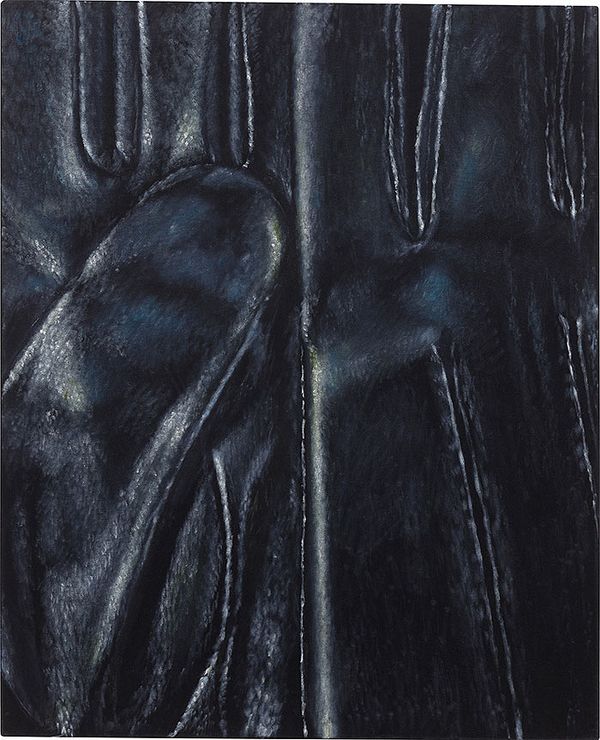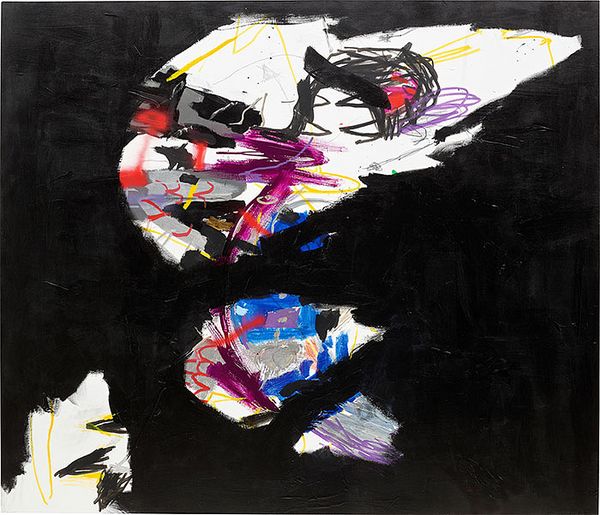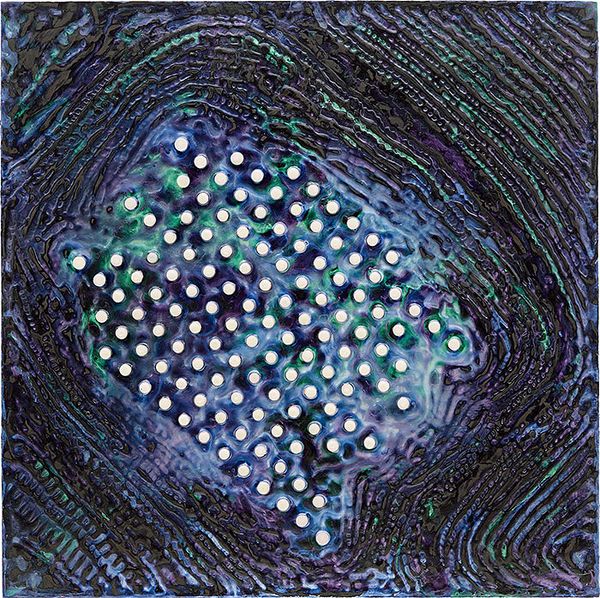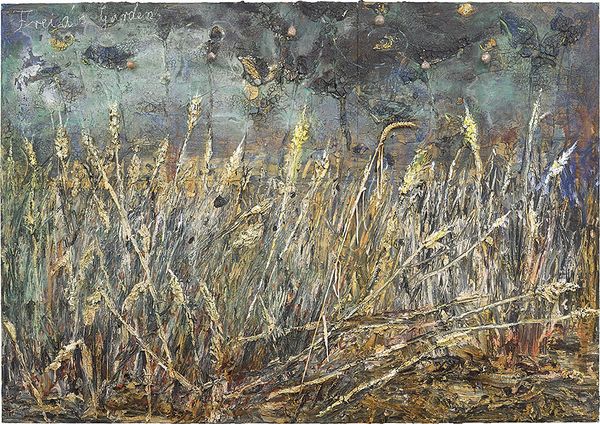Anselm Kiefer, Freia's Garden, 2013. 20th Century & Contemporary Art London.
Phillips' 20th Century & Contemporary Art Sale in London on 3 March is an exceptional number of works whose scale, scope, and variety span from deeply historical landscape rendering to present-day examinations of iconography. We've assembled a roundup of key pieces across the sale for an overview of a remarkable collection.
Anselm Kiefer
Rooted in one of Kiefer’s most enduring motifs – the persistence of nature and blooming of flowers amid a desolate and destroyed landscape – Anselm Kiefer’s Freia’s Garden is a powerfully affecting work from one of the most significant artists working in Germany today. First presented at the Royal Academy’s substantial 2014 retrospective and executed the year before, Freia’s Garden belongs to Kiefer’s Morgenthau series, a cycle of works engaging directly with myth, memory, and the question of German post-war consciousness. The present work is a masterful expression of the innovative and philosophical dimensions of Kiefer’s practice, Kiefer used this armature as a way of imagining an alternative pastoral history that is not only markedly different to the post-war Germany that he grew up in, but that might help us collectively come to terms with a deeply traumatic past. In its monumental scale and arresting, immersive intensity, Freia’s Garden is a paradigmatic example of Kiefer’s reinvention of the landscape tradition. A meditative reflection on the history of landscape painting and of the role that landscape – both real and imagined – continues to play in the German psyche and cultural memory, Freia’s Garden sits at the intersection of the past and the future, the spiritual and the terrestrial, death and rebirth.

Issy Wood, Chalet, 2019. 20th Century & Contemporary Art London.
Issy Wood
Referencing her classical style and the darkly imaginative world that her paintings inhabit, interdisciplinary vanguard artist Issy Wood describes herself as a “medieval millennial.” Taking her source material from old auction catalogues, her grandmother’s compellingly dated possessions, and photographs taken with her phone, Wood unpicks the thread of tragedy that she finds quietly woven through contemporary commodity culture, maintaining a level of temporal dissonance that radically undercuts the sharply polished qualities of traditional Surrealism. Chalet is typical of Wood’s seductive style, belonging to a body of work that includes her closely cropped and magnified images of car interiors, leather jackets, and everyday commodities that are made unsettling in their proximity to bodies, desires, and an alluring darkness that extends far beyond her chromatic preferences, drawing together a wide net of disparate associations including masculinity, deviance, lust, and violence, with the artist self-consciously playing on slippery distinctions between inside and outside, objects and objectification. Velvet painting has been historically designated wealth, prestige, and opulence. Slipping into kitsch in more recent years with popular subjects including depictions of Elvis Presley and Jesus however, the luxury material now also signifies a somewhat seedier set of associations that Wood amplifies to such powerful effect here. Wood’s use of materials draws on the fetishistic – velvet’s tactility, like fur’s, working with the proximity of gloves to hands, human touch, and sensuality to produce a charged erotic symbolism.

Felix Gonzalez-Torres, Untitled (March 5th) #2, 1991. 20th Century & Contemporary Art London.
Felix Gonzalez-Torres
Highly representative of the artist’s conceptual practice in its charged use of everyday objects and expansive thematic scope, “Untitled” (March 5th) #2 marks the Felix Gonzalez-Torres' first use of illuminated light bulbs, directly prefiguring the celebrated light strings which have since become synonymous with the artist. Of the artist’s works made with light bulbs, “Untitled” (March 5th) #2 is poetic in its careful union of concept and execution, the two bare bulbs elegantly suspended from long cords and intertwined like two lives. Contemplative and deeply poetic, it is a profoundly moving sculptural expression that is at once personal and poignantly universal, evoking myriad associations such as love, loss, and the potential for continuous renewal. “Untitled” (March 5th) #2 comprises two standard light bulbs in porcelain sockets, hanging from electrical cords, gently resting in the warm, softly diffused glow of the other. Executed in 1991, the year his partner Ross Laycock died of complications from AIDS, the work may be seen as a discreet celebration of the beginning of life rather than the finitude of death, as the work quietly incorporates Ross’s birthday into the parenthetical portion of its title. Formally, Gonzalez-Torres’s use of parentheses alludes to the subtle ways in which language can shape our experiences, while also ensuring that his own experiences and references do not circumscribe the potential meanings that his work might accrue over time. The profound power of a work like “Untitled” (March 5th) #2 lies not only in the experience of a specific historical moment, not only in the austere and resonant beauty of its form (and its subtle reference to a loved one), but in its graceful proposition that illness and loss are fundamentally interlaced with a potential for infinite renewal.

Alexander Archipenko, Statue on a Triangular Base, 1969. 20th Century & Contemporary Art London.
Alexander Archipenko
Coming to auction directly from the highly distinguished collection of The Museum of Modern Art, New York, this important work by Ukrainian-born sculptor Alexander Archipenko comes with an exceptional provenance.
Statue on a Triangular Base is a preeminent example of the distinctive visual language pioneered by Archipenko during this formative period of his career. One of the earliest artists to apply broadly Cubist techniques to three-dimensional forms, the young Archipenko was a central player in the European avant-garde in the significant early decades of the twentieth century and was included in some of the era’s most definitive exhibitions, including the infamous 1911 Salon des Indépendents and the epoch-defining 1913 Armory Show in New York. Supremely elegant in its careful compositional balance and attention to structural form, the statue extracts the essence of a female figure with a remarkable lightness of touch: presented in an exaggerated contrapposto pose, the angular form of the arm is perfectly mirrored by the triangular base of the title. Poised between these two, opposing diagonal forces, the sculpture contains an enormous amount of energy and kinetic potentiality, recalling the defining sculptural image of a body in motion. Establishing a lively dialogue between material and subject, the rendering of these geometric planes in bronze further accentuates the sense of taut musculature and fluid movement achieved in Archipenko’s treatment of plastic volume.

Renato Guttuso, Aranceto Notturno, 1957. 20th Century & Contemporary Art London.
Renato Guttuso
A testament to its arresting visual power and art historical importance, Renato Guttuso’s Aranceto Notturno comes to auction with exceptional provenance, coming directly from the highly distinguished collection of The Museum of Modern Art, New York.
Renato Guttuso remains one of Italy’s most highly esteemed post-war painters for giving form to a generation’s struggles in the face of Fascist oppression and the destruction wrought by World War II. Aranceto Notturno is typical of the artist’s accessible style and his celebration of the landscape and everyday lives of southern Italy and its people. Although his name is often associated with his more overtly political canvases, Guttuso’s painterly foundations are rooted in his native landscape, commenting later in life that his deepest inspiration was found “in my childhood, my people, my peasants […] the gardens of lemons and oranges.” Guttuso developed his own, distinctive brand of realism counter to the perceived elitism associated with abstraction in favor of a more expressionistic use of line and heavily saturated Mediterranean palette which would prove to be hugely influentially in shaping the artistic currents of Italian art in the immediate post-war period. Richly painted in a flurry of precisely fragmented brushstrokes in alternating flashes of electric blue, deep, mossy greens, limes, and of course the bold, bright orbs of orange edged in white, Aranceto Notturno is a dramatic example of Guttuso’s technical virtuosity and skill.

Robert Nava, Sylvia (87 Sylvia), 2020. 20th Century & Contemporary Art London.
Robert Nava
Robert Nava’s playful and intentionally naïve approach to painting combines a childlike simplicity and nostalgic sense of uninhibited playfulness, allowing him to evoke fantastic narratives in the most direct of means. Sylvia (87 Sylvia) is one of six large-scale canvases exhibited in Nava’s self-titled solo exhibition at Sorry We’re Closed in Brussels in 2020. Each work in the exhibition represents an allegory pertaining to a different irreverent theme from Time to Ecology. Sylvia (87 Sylvia) is the Allegory of Extinction, number 6 of 6, its place in the series is fitting of the finality of its theme. The conception of Sylvia (87 Sylvia) is poised precariously between light and darkness, with two thirds of the picture plane enveloped by the inky blackness of night. As if wiped away, like condensation on a bathroom mirror, gaps in the black pigment create four windows into the scene behind, allowing the viewer glimpses of the monstrous being behind. Heavily abstracted by the encroaching darkness, Nava’s beasts are a tangle of teeth, scales, and claws, interrupted by planes of cobalt blue and gestural strokes of violet. The flashes of red and yellow pierce the picture space, conjuring images of lightning, lasers, and violent spurts of blood. These references to ingenuous violence are possibly what resonates so strongly with a generation of collectors raised on video games, sci-fi and fantasy stories.

KAWS, THIS IS THE WAY, 2014. 20th Century & Contemporary Art London.
KAWS
Larger than life and dominated by vibrantly saturated color, KAWS’ monumental work THIS IS THE WAY synthesizes the artist’s unique blending of art history, pop culture, and contemporary iconography. In the present work, KAWS juxtaposes snippets and fragments from his cast of appropriated characters, fusing them into a singularly specific reinterpretation of the original source material. This collision of familiar cartoons is simultaneously discernable and jarringly unfamiliar, a feverish assembly of referential content in the era of intellectual property ubiquity. Existing within the figure is a medley of superimposed personalities, from comic strip animals Garfield and Odie, to the Muppet Gonzo and the Nickelodeon characters Spongebob Squarepants and Squidward against a recognizable Smurf. In this way KAWS masterfully tips the balance between the innocence and play typically associated with childhood cartoons, promoting a distinctive sense of unease which showcases the artist’s unique capacity to create uncanny and ominous works in equal measure. Commanding in scale and arresting in its vibrant tonality and universally legible pictorial content, THIS IS THE WAY successfully dissolves the purported distinctions between fine art and mass media, culture both high and low, and exemplifies the highly accessible art for which KAWS has become best known.

Jack Whitten, Space Busters III, 2014. 20th Century & Contemporary Art London.
Jack Whitten
Executed in the twilight years of the artist’s radically innovative career, Space Busters III exemplifies Jack Whitten’s thought-provoking and investigative work. Best known for his abstract canvases, mosaic-like composition, and deep engagement with the legacy of African American history, Whitten’s relentless technical experimentalism and exploration into the materiality of painting showcases the painter’s often radical experimentation with his medium; having exhausted the possibilities of paint and brush. In its relentless material creativity, Space Busters III sprawls across the canvas in an incandescent explosion of form and color, examining of the limits of paint in tandem with an overtly sculptural process that juxtaposes two and three-dimensional forms to create a composition bursting with the kind of energy the artist employed to veritably shatter the distinctions between painting and sculpture. Whitten’s playful interrogation of space is analogous to the experimentation and subversion of what might be his foundational artistic inspiration – Jazz. Whitten’s own artistic practice bears the hallmarks of crafted improvision and chromatic alteration characteristic of Jazz music.iii In Space Buster III, the taut lattice of tiny white orbs, sculpted by the artist through casting a mixture of polyurethane and acrylic, provides a clean, static structure, or in musical parlance a composition, around which an improvisation of whorls of inky black, cobalt blue, and jade green paint swirl and oscillate in undulating concentric loops.
Discover More from 20th Century & Contemporary Art >
Recommended Reading
